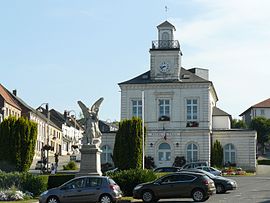Fruges
 From Wikipedia - Reading time: 11 min
From Wikipedia - Reading time: 11 min
Fruges
Frusje | |
|---|---|
 The town hall of Fruges | |
| Coordinates: 50°30′55″N 2°08′04″E / 50.5153°N 2.1344°E | |
| Country | France |
| Region | Hauts-de-France |
| Department | Pas-de-Calais |
| Arrondissement | Montreuil |
| Canton | Fruges |
| Intercommunality | CC Haut Pays du Montreuillois |
| Government | |
| • Mayor (2020–2026) | Edmond Zaborowski[1] |
Area 1 | 18.9 km2 (7.3 sq mi) |
| Population (2021)[2] | 2,329 |
| • Density | 120/km2 (320/sq mi) |
| Time zone | UTC+01:00 (CET) |
| • Summer (DST) | UTC+02:00 (CEST) |
| INSEE/Postal code | 62364 /62310 |
| Elevation | 84–171 m (276–561 ft) (avg. 107 m or 351 ft) |
| 1 French Land Register data, which excludes lakes, ponds, glaciers > 1 km2 (0.386 sq mi or 247 acres) and river estuaries. | |
Fruges (French pronunciation: [fʁyʒ]; West Flemish: Frusje; Picard:Fruches) is a commune in the Pas-de-Calais department in the Hauts-de-France region of France.[3]
Geography
[edit]Situated some 12 miles (19 km) northeast of Montreuil-sur-Mer on the D928 road, set in a valley not far from the historic battlefield of Azincourt.[citation needed]
Features
[edit]Fruges is a typical small country town in the Pas-de-Calais with a weekly market, agricultural suppliers, a Carrefour and various smaller stores.
An annual Fête des Géants livens up August with parades of marching bands and papier mache giants.
Population
[edit]| Year | Pop. | ±% p.a. |
|---|---|---|
| 1968 | 2,460 | — |
| 1975 | 2,534 | +0.42% |
| 1982 | 2,465 | −0.39% |
| 1990 | 2,499 | +0.17% |
| 1999 | 2,426 | −0.33% |
| 2007 | 2,533 | +0.54% |
| 2012 | 2,460 | −0.58% |
| 2017 | 2,371 | −0.73% |
| Source: INSEE[4] | ||
Places of interest
[edit]- Church of St. Bertulphe, dating from the nineteenth century.
Twin towns
[edit]Fruges is twinned with Olsberg, Germany, since 1965.
Transport
[edit]The Chemin de fer d'Anvin à Calais opened a railway station at Fruges in 1881.[5] From 1891, the station was also served by the Chemins de fer d'Aire à Fruges et de Rimeux-Gournay à Berck.[6] The railways were closed in 1955.[7]
See also
[edit]References
[edit]- ^ "Répertoire national des élus: les maires". data.gouv.fr, Plateforme ouverte des données publiques françaises (in French). 2 December 2020.
- ^ "Populations légales 2021" (in French). The National Institute of Statistics and Economic Studies. 28 December 2023.
- ^ INSEE commune file
- ^ Population en historique depuis 1968, INSEE
- ^ Farebrother & Farebrother 2008, p. 31.
- ^ Farebrother & Farebrother 2008, p. 83.
- ^ Farebrother & Farebrother 2008, pp. 281–82.
Sources
[edit]- Farebrother, Martin J B; Farebrother, Joan S (2008). Tortillards of Artois. Usk: The Oakwood Press. ISBN 978-0-85361-679-5.
 KSF
KSF


